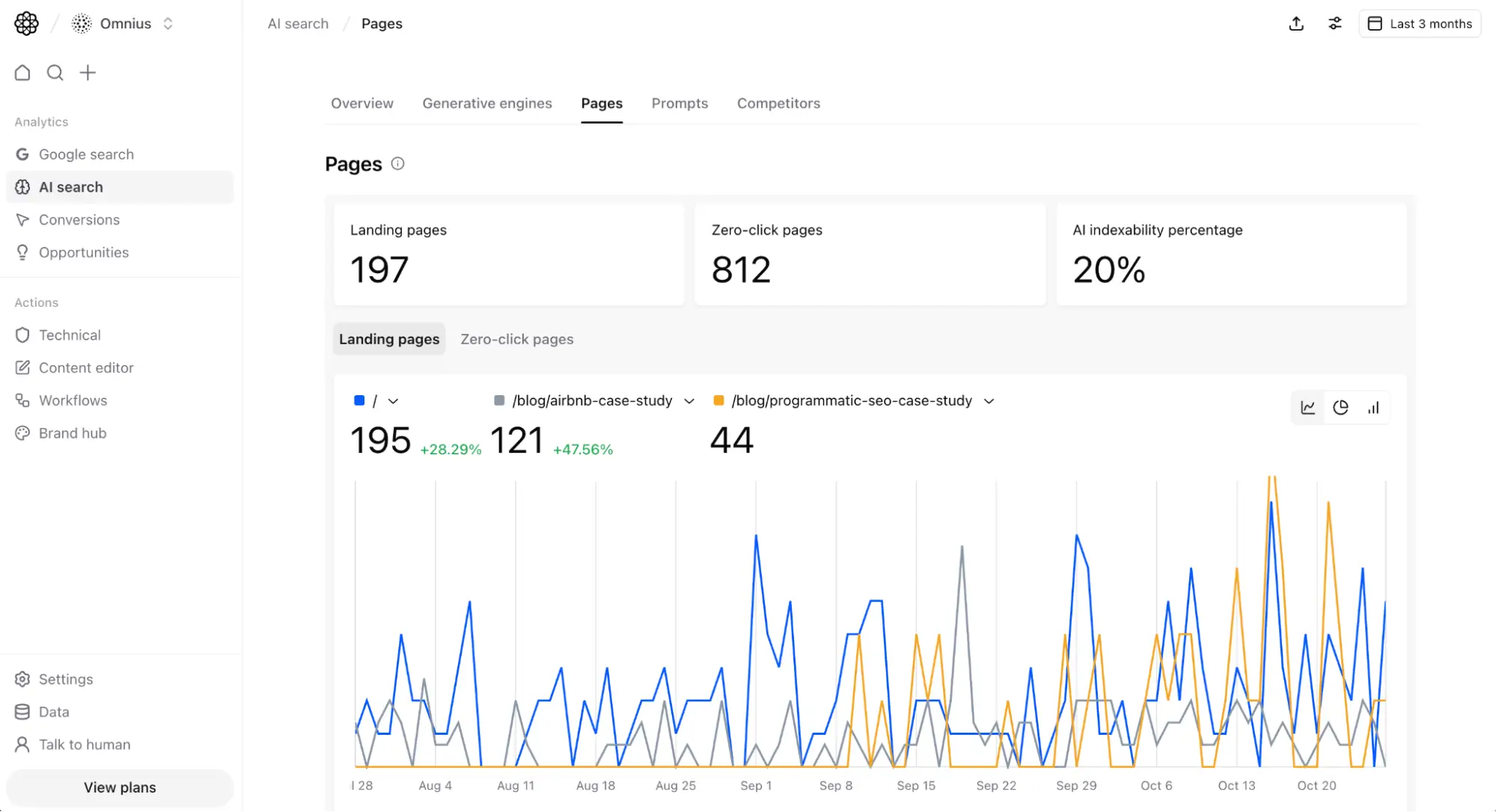






Generative search visibility now extends beyond traditional SERPs. As AI engines increasingly summarize, reference, and cite web content directly, brands need clarity on which pages are being surfaced, how users interact with them, and whether those interactions lead to measurable outcomes. The AI Search Landing Page Analysis view in AtomicAGI brings this visibility to the page level, providing concrete data where most SEO tools rely on inference.
The module aggregates and reconciles evidence-based metrics from AI search engines (ChatGPT, Perplexity, Gemini, Claude, Copilot) and cross-validates them against GA4 interaction data. Each landing page listed in the dashboard represents an AI-discoverable asset - a URL that appears within generative answers, receives AI-driven traffic, or demonstrates indirect engagement through visibility events.
At its core, the analysis connects three main signals:
Each signal is labeled as evidence or modeled, based on whether it’s directly verified (clicks, conversions) or inferred (Zero-Click visibility). This hybrid approach ensures transparent attribution in an environment where direct traffic from AI results is still emerging.
The overview graph at the top of the module visualizes total AI clicks and conversions over time, showing how visibility translates into engagement trends. Spikes often correspond to updates in AI models or content refreshes, providing early diagnostic signals of shifting AI behavior.
The table below lists top-performing landing pages, each with corresponding metrics for click growth, conversion delta, and average session time. Pages highlighted with positive deltas often indicate increased AI citations or improved indexability following schema updates.
For example, a URL like /blog/leading-us-saas-startups may show a +677% increase in clicks and +80% longer session duration, suggesting improved alignment with AI-crawled context or higher mention frequency within generative answers.
All metrics follow Atomic’s hybrid evidence + synthetic modeling structure:
Each page metric is reconciled through Atomic’s validation pipeline, which cross-references timestamps, event sequences, and known engine behavior. The pipeline ensures temporal alignment between AI model activity and measurable outcomes, filtering anomalies such as duplicate events or low-confidence mentions.
This methodology transforms unstructured AI search outputs into traceable, per-URL evidence streams that map directly to real-world user behavior.
In 2025, more than 45% of web searches globally surface an AI-generated summary. Yet the majority of these experiences result in Zero-Click visibility-content that shapes AI responses without driving site visits. For SEO and content teams, this means traditional analytics fail to capture where brand assets influence users.
Atomic’s AI Search Landing Page Analysis bridges that gap. It surfaces which pages have entered AI visibility ecosystems and how that exposure translates to actual engagement. Tracking AI clicks alongside Zero-Click visibility helps teams measure latent influence - the hidden value of being cited within AI answers even before measurable traffic arrives.
Each metric within the dashboard carries operational meaning:
Monitoring the balance between click growth and average session duration helps teams understand not only how often their pages appear, but also whether those appearances result in qualified engagement.
Teams typically use this module to:
For example, a SaaS company monitoring a product landing page might see an increase in AI Clicks from Gemini alongside higher Average Time, signaling deeper AI-contextual traffic worth prioritizing for content expansion.
AI Search Landing Page Analysis integrates with Atomic’s broader Search Intelligence architecture:
Together, these integrations transform page-level monitoring into a closed analytical loop, aligning content, technical SEO, and AI visibility performance.

An AI landing page is a URL detected as visible, cited, or clicked within AI search results. Atomic identifies these through verified evidence or modeled visibility.
Atomic currently tracks ChatGPT, Perplexity, Gemini, Claude, and Copilot, with additional connectors for DeepSeek, Poe, and iAsk in development.
Zero-Click visibility is modeled based on Atomic’s AI detectors, which identify brand or URL mentions within AI-generated responses that did not result in measurable clicks.
Evidence metrics refresh daily, while modeled AI visibility signals update continuously as new AI queries and responses are detected.
Modeled metrics are labeled with confidence levels. Evidence-based clicks are verified sessions, while modeled visibility represents strong directional signals.
Yes. Conversion tracking is integrated through GA4, enabling analysis of AI traffic quality and outcomes at the page level.
Use Atomic’s LLM Audit and Content Intelligence modules to assess schema quality, entity coverage, and topical depth. Low conversions with rising AI visibility often indicate missing structured data or weak alignment with intent-driven queries.


Integrate your data sources with Atomic in as little as 5 minutes.

Integrate with Atomic, and get up & running in 5 minutes.

Your data is visible only to you. Our system is completely encrypted.